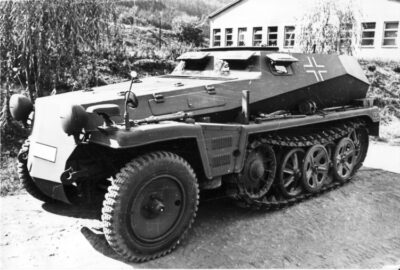Normandy late August 1944. Intense fighting raged around the village of Saint Lambert-sur-Dives. The Allies remorselessly crushed German forces into an ever-tightening pocket around the town of Falaise in the final stages of the Battle of Normandy. One of the units in the desperate drive to break out of the Allied encirclement in the retreat back to Germany was the 10th SS Panzer Division 'Frundsberg'. By the end of the battle the roads and fields around the village were littered with shattered German vehicles and equipment. The war moved on. The wreckage was removed or left half buried to be forgotten over the decades.
Nearly 70 years after this engagement, in 2005, we received large sections of what appeared to be a Sd.Kfz.250 Ausf. A, still retaining vestiges of its original camouflage and a key tactical marking. This light German armoured half track included the complete left hand side armour panel, with the track fender cover and the rear panel without the access door.
We already had a completely intact and original Sd.Kfz.250 Ausf. However, before we obtained this Sd.Kfz.250, it had been blasted and painted. These actions had obliterated the original camouflage, unit insignia or tactical markings.
Unfortunately, we were unable to determine the camouflaged Sd.Kfz.250’s division, or where it had been found other than in Normandy. The only certainty was in the numbers which indicated it was from the 3rd Kompanie (Company), 1st Zug (Platoon), and was the 7th (vehicle).
These two vehicles presented us with an interesting choice. Should we restore a complete Sd.Kfz.250, without any markings, no unit designation, or history. Or restore the incomplete Sd.Kfz.250, with its camouflage and markings.
We were now leaning towards restoring the unknown Sd.Kfz.250 Ausf. A. Particularly as there was too much uncertainty with the camouflaged Sd.Kfz.250 Ausf. A and less of the vehicle to refurbish.
Then some time later a number of books and photographs were published detailing the operational history of the Frundsberg Division. These provided numerous black and white photos of Frundsberg Sd.Kfz.250s in Normandy and photos of a number of relics recovered from the battlefield. One publication provided a glimpse of useful additional documents. We decided to take a closer look at our camouflaged Sd.Kfz.250.
We had the original camouflage pattern and we strongly suspected the vehicle was a Frundsberg Sd.Kfz.250. Our initial investigation revealed several discrepancies with the interior configurations between our Sd.Kfz.250 Ausf.A and any of the documented Sd.Kfz.250 Ausf.A. We spent hours studying the Sd.Kfz.250 Beladeplan manual and other original archive photographs.
Our research team then concentrated on the Tactical number markings 317, 3rd company, 1st platoon, 7th vehicle and ran through all of the K.St.N (Kriegsstärkenachweisung ) options. The K.St.N gave the standard equipment and organization for a unit. We tracked down K.St.N 1113(gp) of 1/11/43 had a number of Sd.Kfz.250/1. This was the first solid indication of where in the unit our Sd.Kfz.250/1 belonged in late 1944.
Further research using an OQu (Oberquartiermeister ) report for the entire SS-Panzeraufklärungs-Abteilung 10 (SS-Pz-AA 10) dated 1 June 1944, listed an unusually large number of Sd.Kfz.250. Our focus on Sd.Kfz.250/1s within the report revealed that the Frundsberg Division had 51 Ist (actual) against 44 Soll (should have). The 2nd Zug were Sd.Kfz.250 Ausf. Bs. The 3rd Zug of the SS-Pz-AA 10 were predominantly 250 Ausf. Making the photographic archive search for our 250’s companion vehicles simpler.
The best view there is of the unit's strength is the Gliederung for 10th SS dated 1 June 1944 confirms 33 250s within the 3rd Zug of the Aufklärung Abteilung.
All of these documents - the various K.St.N, the OQu and the Gliederung - confirmed the existence of our Sd.Kfz.250/1 Ausf. A in the unit at the beginning of June just prior to the Normandy invasion.
Shortly after this research, we received confirmation other parts from our vehicle had been recovered including the missing rear door and the MG shield. The door bore the unit insignia of the Frundsberg Division and the same tactical number. The rear section containing the missing rear door was confirmed to have originally been part of the main armoured left hand side panel. We could now establish the vehicle had been found in the area just west of Saint Lambert-sur-Dives at the original crossing point of Frundsberg over the River Dives in August 1944. Our initial examination of the unit history provided dates between 19th and the 23rd August for the Saint Lambert action.
We now had a confirmed 7th vehicle, 1st Section of the SS-Pz-AA 10, 3rd Company.
Resurrection of the Frundsberg Sd.Kfz.250 can be achieved through using the unknown Sd.Kfz.250 as a donor vehicle as both are identical in construction. We plan to graft in the donor panels into those of the Frundsberg vehicle. The restoration process, once complete, will return the 7th vehicle of the 1st Section, 3rd Company of SS-Pz-AA 10 Division Frundsberg, once more to this world after the catastrophic end to her operational life in late August 1944.
- This article has 846 words
- Reading time: 4 minutes
- There are 3 photos
Become a Member - Access the Full Article
Members gain access to the full content of our articles, including photo galleries.


